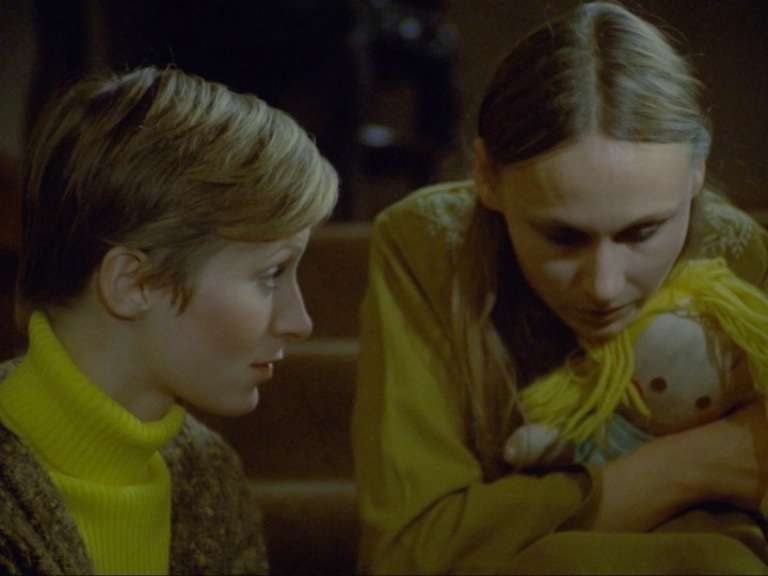« Coffee Break | Main | Coffee Break »
May 10, 2016
Symptoms

Jose Ramon Larraz - 1974
BFI Blu-ray/DVD two disc set
The near loss of Symptoms is a reminder that even when the idea of film preservation was gaining attention, it was still possible for even a relatively recent film to be totally lost. In the case of Symptoms, the existence of that film was visible in murky bootleg VHS tapes. The discovery of the negative was followed by digital restoration, and the newly available Blu-ray/DVD release. The film probably looks better than it did in theatrical release where it popped in a couple of grind houses stateside to critical and audience indifference. In the case of the U.S. run, it didn't help that this was one of the last films from distributor Bryanston prior to its closure from bankruptcy. Symptoms, much to the surprise of those involved, was the British entry at Cannes. It should be no surprise that an intimate horror film would be overshadowed in a line-up that included films by Francis Ford Coppola, Steven Spielberg, Robert Altman, R.W. Fassbinder and Alain Resnais, among the heavier hitters in competition.
The career of Larraz was a bit unconventional, moving from cartoons and photography to filmmaking at forty. The high points of Larraz's filmography are the handful of films made in England, signed as Joseph Larraz. Aside from the censorship of art that was standard in Spain at the time Larraz made his first films, those involved in making horror films were forced to use pseudonyms to disguise their Spanish identity. As in the other two British films I've seen, Vampyres and The House that Vanished, Larraz likes to set his films in mansions hidden in the countryside.

Larraz makes the most of the country setting in Symtoms, with its heavily wooded area in Autumn, and leaves nearly covering a nearby lake. The colors of Autumn are echoed frequently in the colors of the clothing worn by the two main female characters. An arm and leg of a woman can be glimpsed. Two women, Helen and Anne drive up to a very large house belonging to Anne. Only a few rooms are still used according to Helen. While Helen is returning from a visit to Switzerland, Anne is taking time from breaking up with her boyfriend. Helen is very girlish in appearance with her long hair and dresses. Anne could almost be mistaken for David Bowie with her boyish hairstyle. Yet it is Helen who glances at Anne with an unstated desire. Interrupting the shared quiet of walking through the woods and homemade meals is the presence of the handyman, Brady, who lives nearby. Seen at one point wearing a wife beater undershirt with a straight razor nearby, Brady would seem to represent brutish masculinity barging in on a refined, feminine world.
Helen has a couple of framed photos of a friend, Cora. The extent of that friendship is never discussed other than that Cora was Helen's houseguest recently. More puzzling for Anne are the sounds of laughter and moaning, either from pleasure or pain, heard late at night. There may be an unexpected visitor, glanced at as a reflection on a mirror, or heard padding around in the attic.
The Blu-ray comes with several supplements. The documentary, On Vampyres and other Symtoms, by Celia Novis, combines biography in graphic art illustrations, with excerpts from several of Larraz's early films, along with Larraz being honored at the Stiges Film Festival in 2009, with a screening of Vampyres. Novis blends shots from Larraz's films with footage of Larraz walking through parts of Barcelona and his hotel. Without having to state it outright, the documentary make the case for Larraz as an auteur based as much on the recurring visual choices as well as his interest in the fantastique. Further investigation requires a look at the writings of the Belgian writer with the pen name of Thomas Owen, who provided inspiration for Larraz. Editor Brian Smedley-Aston, who also produced Vampyres provides a unique link with British film history as the nephew of Frank Launder, one of the mainstays of classic British cinema, and editor for Tony Richardson and Desmond Davis during Britain's own New Wave of the early Sixties. Smedley-Aston, along with stars Angela Pleasence and Lorna Heilbron, are interviewed. Pete Tombs, who with Cathal Tohill, first brought renewed critical attention to Larraz with their book, Immoral Tales, produced several of the supplements. There is also a booklet which includes a deeper examination of Symptoms as well as the rave review by the then young film critic, David Pirie, written in 1974, a time when many fellow cineastes were taking seriously the genre films of the past, while often ignoring what was currently on screen.

The above screen grabs are from the DVD, which like the Blu-ray, is not region locked.
Posted by Peter Nellhaus at May 10, 2016 05:12 PM
